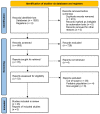Appendiceal Mucinous Neoplasms and Inflammatory Bowel Disease: Systematic Review of the Literature
- PMID: 38202199
- PMCID: PMC10780220
- DOI: 10.3390/jcm13010191
Appendiceal Mucinous Neoplasms and Inflammatory Bowel Disease: Systematic Review of the Literature
Abstract
There is no clear evidence on the prevalence and clinical presentation of appendiceal mucinous neoplasm (AMN) among patients with inflammatory bowel disease (IBD), so a systematic review was performed to investigate the diagnosis, management and treatment of AMN in these patients. PubMed, Medline, Scopus and the Cochrane Library were searched for articles published up to September 2023. Twenty-three studies reporting data about 34 AMN patients were included. UC patients had a median age of 52 years and a median length of disease of 10 years; CD patients had a median age of 40.5 years and a median length of disease of 5 years. A pre-operative diagnosis was achieved in 44% of patients. Most patients were symptomatic (82.6%) and showed moderate-severe disease activity (61%). Surgical procedures were performed: laparoscopic appendectomy, ileocecal resection, right hemicolectomy and colectomy/proctocolectomy. Of the patients, 73.5% were diagnosed with low-grade mucinous neoplasm (LAMN) and nine with adenocarcinoma. Synchronous colorectal dysplasia/carcinoma was present in 23.5% of patients. IBD patients with long-standing disease should be routinely screened, not only for colorectal cancer but also for AMN, during gastro-enterologic follow-up. Laparoscopic appendectomy of unruptured LAMN as well as right hemicolectomy of non-metastatic adenocarcinoma are safe procedures in IBD patients.
Keywords: Crohn’s disease; appendiceal mucinous neoplasm; systematic review; ulcerative colitis.
Conflict of interest statement
The authors declare no conflicts of interest.
Figures
References
-
- Glasgow S.C., Gaertner W., Stewart D., Davids J., Alavi K., Paquette I.M., Steele S.R., Feingold D.L. The American Society of Colon and Rectal Surgeons, Clinical Practice Guidelines for the Management of Appendiceal Neoplasms. Dis. Colon Rectum. 2019;62:1425. doi: 10.1097/DCR.0000000000001530. - DOI - PubMed
-
- Carr N.J., Cecil T.D., Mohamed F., Sobin L.H., Sugarbaker P.H., González-Moreno S., Taflampas P., Chapman S., Moran B.J. A Consensus for Classification and Pathologic Reporting of Pseudomyxoma Peritonei and Associated Appendiceal Neoplasia: The Results of the Peritoneal Surface Oncology Group International (PSOGI) Modified Delphi Process. Am. J. Surg. Pathol. 2016;40:14. doi: 10.1097/PAS.0000000000000535. - DOI - PubMed



